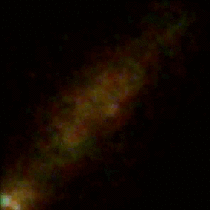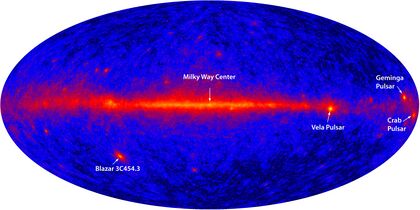نباض الشراع
| بيانات الرصـد الحقبة J2000 اعتدال J2000 | |
|---|---|
| الكوكبة | Vela |
| الصعود المستقيم | 08س 35د 20.65525ث[1] |
| الميل | −45° 10′ 35.1545″[1] |
| القدر الظاهري (V) | 23.6 |
| علم القياسات الفلكية | |
| المسافة | 959+248 −163 س ض (294+76 −50[2] ف ن) |
| تسميات أخرى | |
| مراجع قواعد البيانات | |
| SIMBAD | data |
The Vela Pulsar (PSR J0835-4510 or PSR B0833-45) is a radio, optical, X-ray- and gamma-emitting pulsar associated with the Vela Supernova Remnant in the constellation of Vela. Its parent Type II supernova exploded approximately 11,000–12,300 years ago (and was about 800 light-years away).
Characteristics
Vela is the brightest pulsar (at radio frequencies) in the sky and spins 11 times per second[3] (i.e. a period of 89.33 milliseconds—the shortest known at the time of its discovery) and the remnant from the supernova explosion is estimated to be travelling outwards at 1،200 km/s (750 mi/s).[4] It has the third-brightest optical component of all known pulsars (V = 23.6 mag)[5] which pulses twice for every single radio pulse. The Vela pulsar is the brightest persistent object in the high-energy gamma-ray sky.
Pulsed emission up to 20 TeV has been detected from the Vela pulsar and together with the Crab pulsar at 1.5 TeV[6] are the only two known pulsar with emission in this energy range[7]
Glitches
Glitches are sudden spin-ups in the rotation of pulsars. Vela is the best known of all the glitching pulsars, with glitches occurring on average every three years. Glitches are currently not predictable.[8]
On 12 December 2016, Vela was observed to glitch live for the first time with a radio telescope (the 26 m telescope at the Mount Pleasant Radio Observatory) large enough to see individual pulses. This observation showed that the pulsar nulled (i.e. did not pulse) for one pulse, with the pulse prior being very broad and the two following pulses featuring low linear polarization.[9] It also appeared that the glitch process took under five seconds to occur and allowed to estimate physical properties of the pulsar.[10][11][8]
On 22 July 2021, a new glitch occurred. As a result, the period of the pulsar decreased by about 1 part in a million.[12]
Statistically, nearly the 1% of the long-term spin-down of the pulsar is reversed in spin-up glitches, a fraction that is also observed in other monitored pulsars.[13][8] Careful estimation of the glitch activity and its uncertainty requires statistical tools beyond the simple linear regression.[14]
Research campaigns
The association of the Vela pulsar with the Vela Supernova Remnant, made by astronomers at the University of Sydney in 1968,[15] was direct observational proof that supernovae form neutron stars.
Studies conducted by Kellogg et al. with the Uhuru spacecraft in 1970–71 showed the Vela pulsar and Vela X to be separate but spatially related objects. The term Vela X was used to describe the entirety of the supernova remnant.[16] Weiler and Panagia established in 1980 that Vela X was actually a pulsar wind nebula, contained within the fainter supernova remnant and driven by energy released by the pulsar.[17]
Nomenclature
The pulsar is occasionally referred to as Vela X, but this phenomenon is separate from either the pulsar or the Vela X nebula. A radio survey of the Vela-Puppis region was made with the Mills Cross Telescope in 1956–57 and identified three strong radio sources: Vela X, Vela Y, and Vela Z. These sources are observationally close to the Puppis A supernova remnant, which is also a strong X-ray and radio source.[18]
Neither the pulsar nor either of the associated nebulae should be confused with Vela X-1, an observationally close but unrelated high-mass X-ray binary system.
In music
The emissions of Vela and the pulsar PSR B0329+54 were converted into audible sound by French composer Gérard Grisey and used in the piece Le noir de l'étoile (1989–90).[19][20][21]
Gallery
Cycle of pulsed gamma rays from the Vela pulsar
Video consisting of eight images of Vela's particle jet, looped continuously
References
- ^ أ ب "NAME Vela Pulsar". SIMBAD. Centre de données astronomiques de Strasbourg. Retrieved 9 يناير 2013.
- ^ Caraveo, P. A.; De Luca, A.; Mignani, R. P.; Bignami, G. F. (نوفمبر 2001). "The Distance to the Vela Pulsar Gauged with Hubble Space Telescope Parallax Observations". Astrophys. J. 561 (2): 930–937. arXiv:astro-ph/0107282. Bibcode:2001ApJ...561..930C. doi:10.1086/323377. S2CID 119069765.
- ^ Manchester, R. N.; Hobbs, G. B.; Teoh, A.; Hobbs, M. (أغسطس 2005). "ATNF Pulsar Catalogue: J0835-4510". VizieR On-line Data Catalog. Bibcode:2005yCat.7245....0M.
- ^ Lyne, Andrew G.; Graham-Smith, Francis (1998). Pulsar Astronomy (2nd ed.). Cambridge University Press. ISBN 0-521-59413-8.
- ^ Mignani, R. P.; Zharikov, R. P.; Caraveo, P. A. (أكتوبر 2007). "The Optical Spectrum of the Vela Pulsar". Astronomy and Astrophysics. 473 (3): 891–896. arXiv:0707.2036. Bibcode:2007A&A...473..891M. doi:10.1051/0004-6361:20077774. S2CID 15433523.
- ^ The H.E.S.S. Collaboration; Aharonian, F.; Benkhali, F. Ait; Aschersleben, J.; Ashkar, H.; Backes, M.; Martins, V. Barbosa; Batzofin, R.; Becherini, Y.; Berge, D.; Bernlöhr, K.; Bi, B.; Böttcher, M.; Boisson, C.; Bolmont, J.; et al. (5 أكتوبر 2023). "Discovery of a radiation component from the Vela pulsar reaching 20 teraelectronvolts". Nature Astronomy (in الإنجليزية). arXiv:2310.06181. doi:10.1038/s41550-023-02052-3. ISSN 2397-3366.
- ^ The H.E.S.S. Collaboration; Aharonian, F.; Benkhali, F. Ait; Aschersleben, J.; Ashkar, H.; Backes, M.; Martins, V. Barbosa; Batzofin, R.; Becherini, Y.; Berge, D.; Bernlöhr, K.; Bi, B.; Böttcher, M.; Boisson, C.; Bolmont, J. (5 أكتوبر 2023). "Discovery of a radiation component from the Vela pulsar reaching 20 teraelectronvolts". Nature Astronomy (in الإنجليزية). arXiv:2310.06181. doi:10.1038/s41550-023-02052-3. ISSN 2397-3366.
- ^ أ ب ت Antonelli, Marco; Montoli, Alessandro; Pizzochero, Pierre (November 2022), Insights into the physics of neutron star interiors from pulsar glitches, pp. 219–281, http://arxiv.org/abs/2301.12769, retrieved on 2023-09-25
- ^ Palfreyman, J.; Dickey, J. M.; Hotan, A.; Ellingsen, S.; van Straten, W. (أبريل 2018). "Alteration of the magnetosphere of the Vela pulsar during a glitch". Nature. 556 (7700): 219–222. Bibcode:2018Natur.556..219P. doi:10.1038/s41586-018-0001-x. PMID 29643483. S2CID 4708813.
- ^ Ashton, G. "Rotational evolution of the Vela pulsar during the 2016 glitch".
- ^ Montoli, Alessandro; Antonelli, Marco; Magistrelli, Fabio; Pizzochero, Pierre (أكتوبر 2020). "Bayesian estimate of the superfluid moments of inertia from the 2016 glitch in the Vela pulsar". Astronomy & Astrophysics. 642: A223. arXiv:2005.01594. doi:10.1051/0004-6361/202038340. ISSN 0004-6361.
- ^ V. Sosa-Fiscella; E. Zubieta; S. del Palacio; F. Garcia; et al. (23 يوليو 2021). "A new Glitch in the Vela Pulsar (PSR B0833-45/PSR J0835-4510)". The Astronomer's Telegram. Retrieved 24 يوليو 2021.
- ^ McKenna, J.; Lyne, A. G. (يناير 1990). "PSR1737–30 and period discontinuities in young pulsars". Nature (in الإنجليزية). 343 (6256): 349–350. doi:10.1038/343349a0. ISSN 1476-4687.
- ^ Montoli, Alessandro; Antonelli, Marco; Haskell, Brynmor; Pizzochero, Pierre (5 يناير 2021). "Statistical estimates of the pulsar glitch activity". Universe. 7 (1): 8. doi:10.3390/universe7010008. hdl:2434/903235. ISSN 2218-1997.
- ^ Large, M. I.; Vaughan, A. E.; Mills, B. Y. (أكتوبر 1968). "A Pulsar Supernova Association?". Nature. 20 (5165): 340–341. Bibcode:1968Natur.220..340L. doi:10.1038/220340a0. S2CID 32855796.
- ^ Kellogg, E.; Tananbaum, H.; Harnden, F. R. Jr.; Gursky, H.; Giacconi, R.; Grindlay, J. (أغسطس 1973). "The X-ray Structure of the Vela X Region Observed from Uhuru". The Astrophysical Journal. 183: 935–940. Bibcode:1973ApJ...183..935K. doi:10.1086/152279.
- ^ Weiler, K. W.; Panagia, N. (أكتوبر 1980). "Vela X and the Evolution of Plerions". Astronomy and Astrophysics. 90 (3): 269–282. Bibcode:1980A&A....90..269W.
- ^ Rishbeth, H. (ديسمبر 1958). "Radio Emission from the Vela-Puppis Region". Australian Journal of Physics. 11 (4): 550–563. Bibcode:1958AuJPh..11..550R. doi:10.1071/PH580550.
- ^ Del Re, Giuseppe (2000). The Cosmic Dance: Science Discovers the Mysterious Harmony of the Universe. Philadelphia: Templeton Foundation. pp. 24–25. ISBN 978-1-890151-25-6.
- ^ Luminet, Jean-Pierre (2011). Illuminations: Cosmos et esthétique (in الفرنسية). Paris: Odile Jacob. pp. 419–420. ISBN 978-2-7381-2562-0.
- ^ قالب:IRCAM work
External links


